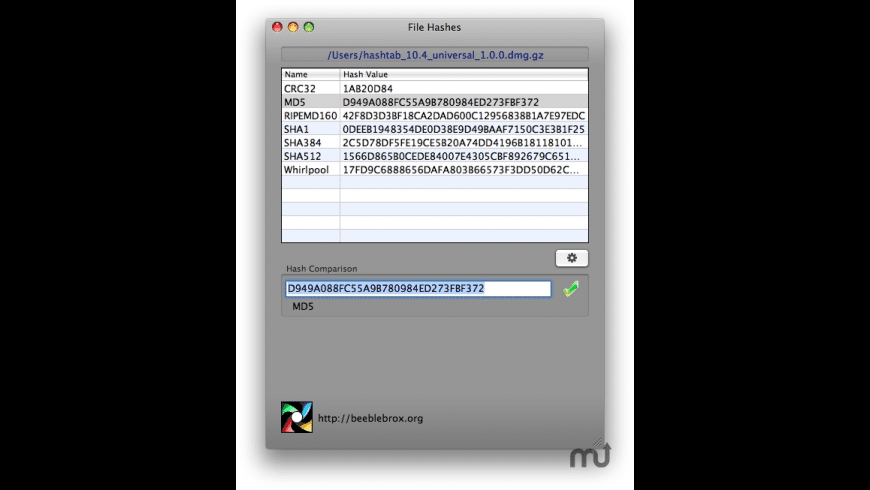- Product description. Spend an evening around the campfire with friends or enjoy binge watching your favorite show with our extra-strength ultra-relaxing Hashtab. Each swallowable tablet contains 25 mg of ice water hash and takes effect in 30–90 minutes, with a duration of 2–4 hours.
- A hash is a file's unambiguous identifier obtained based on different algorithms. If for whatever reason you need to find out what these codes are, HashTab is an application for Windows that lets you look up the MD5, SHA1, and CRC-32 hashes for any file.
Overview
HashTab is a Freeware software in the category Audio & Multimedia developed by Beeblebrox.org.
It was checked for updates 3,738 times by the users of our client application UpdateStar during the last month.
The latest version of HashTab is 6.0.0.34, released on 03/30/2018. It was initially added to our database on 08/26/2007. The most prevalent version is 2.1.1, which is used by 41 % of all installations.
The following example shows how to create, initialize and perform various functions to a Hashtable and how to print out its keys and values. Using namespace System; using namespace System::Collections; public ref class Example public: static void Main // Create a new hash table. Personally, I prefer HashCheck over HashTab because of its ability to create and verify checksum files (.sfv,.md5, sha1, etc.). It doesn’t support as many algorithms as HashTab but that’s OK because of the relative rarity of many of these algorithms. HashTab is a Freeware software in the category Audio & Multimedia developed by Beeblebrox.org. It was checked for updates 4,273 times by the users of our client application UpdateStar during the last month. The latest version of HashTab is 6.0.0.34, released on. It was initially added to our database on.
HashTab runs on the following operating systems: Windows. The download file has a size of 0.9MB.
Users of HashTab gave it a rating of 4 out of 5 stars.
Write a review for HashTab!
| 04/21/2021 | DAEMON Tools Lite 10.14.0.1744 |
| 04/21/2021 | KoolMoves 10.1.3 |
| 04/21/2021 | GoodSync 11.6.4.4 |
| 04/21/2021 | EssentialPIM Free 9.8 |
| 04/21/2021 | RadioBOSS 6.0.5.3 |
| 04/19/2021 | Firefox 88 available for download |
| 04/16/2021 | Security updates for Chromium-based Brave, Vivaldi and Edge |
| 04/15/2021 | Chrome 90 update released |
| 04/14/2021 | Adobe closes critical Photoshop vulnerabilities with April updates |
| 04/13/2021 | New Chrome 89.0.4389.128 fixes two zero day vulnerabilities |
- » sha1 avec hashtab
- » hashtab pobierz
- » hashtab 更新
- » hashtab 5 descargar
- » hashtab 6
- » luka hashtab hashish
- » hashtab официальный сайт
- » hashtab nedir
- » hash tab 評価
- » hashtab 4
SHORT DESCRIPTION

Describes how to create, use, and sort hash tables in PowerShell.
LONG DESCRIPTION
A hash table, also known as a dictionary or associative array, is a compactdata structure that stores one or more key/value pairs. For example, a hashtable might contain a series of IP addresses and computer names, where the IPaddresses are the keys and the computer names are the values, or vice versa.
In PowerShell, each hash table is a Hashtable (System.Collections.Hashtable)object. You can use the properties and methods of Hashtable objects inPowerShell.
Beginning in PowerShell 3.0, you can use the [ordered] attribute to create anordered dictionary (System.Collections.Specialized.OrderedDictionary) inPowerShell.
Ordered dictionaries differ from hash tables in that the keys always appear inthe order in which you list them. The order of keys in a hash table is notdetermined.
The keys and value in hash tables are also .NET objects. They are most oftenstrings or integers, but they can have any object type. You can also createnested hash tables, in which the value of a key is another hash table.
Hash tables are frequently used because they are very efficient for findingand retrieving data. You can use hash tables to store lists and to createcalculated properties in PowerShell. And, PowerShell has a cmdlet,ConvertFrom-StringData, that converts strings to a hash table.
Syntax
The syntax of a hash table is as follows:
The syntax of an ordered dictionary is as follows:
The [ordered] attribute was introduced in PowerShell 3.0.
Creating Hash Tables
To create a hash table, follow these guidelines:
- Begin the hash table with an at sign (@).
- Enclose the hash table in braces ({}).
- Enter one or more key/value pairs for the content of the hash table.
- Use an equal sign (=) to separate each key from its value.
- Use a semicolon (;) or a line break to separate the key/value pairs.
- Key that contains spaces must be enclosed in quotation marks. Values must bevalid PowerShell expressions. Strings must appear in quotation marks, even ifthey do not include spaces.
- To manage the hash table, save it in a variable.
- When assigning an ordered hash table to a variable, place the [ordered]attribute before the '@' symbol. If you place it before the variable name, thecommand fails.
To create an empty hash table in the value of $hash, type:
You can also add keys and values to a hash table when you create it. Forexample, the following statement creates a hash table with three keys.
Creating Ordered Dictionaries
You can create an ordered dictionary by adding an object of theOrderedDictionary type, but the easiest way to create an ordered dictionary isuse the [Ordered] attribute.
The [ordered] attribute is introduced in PowerShell 3.0.
Place the attribute immediately before the '@' symbol.

You can use ordered dictionaries in the same way that you use hash tables.Either type can be used as the value of parameters that take a hash table ordictionary (iDictionary).
You cannot use the [ordered] attribute to convert or cast a hash table. If youplace the ordered attribute before the variable name, the command fails withthe following error message.
To correct the expression, move the [ordered] attribute.
You can cast an ordered dictionary to a hash table, but you cannot recover theordered attribute, even if you clear the variable and enter new values. Tore-establish the order, you must remove and recreate the variable.
Displaying Hash Tables
To display a hash table that is saved in a variable, type the variable name.By default, a hash tables is displayed as a table with one column for keys andone for values.
Hash tables have Keys and Values properties. Use dot notation to display allof the keys or all of the values.
Each key name is also a property of the hash table, and its value is the valueof the key-name property. Use the following format to display the propertyvalues.
For example:
If the key name collides with one of the property names of the HashTable type,you can use PSBase to access those properties. For example, if the key nameis keys and you want to return the collection of Keys, use this syntax:
Hash tables have a Count property that indicates the number of key-value pairsin the hash table.
Hash table tables are not arrays, so you cannot use an integer as an indexinto the hash table, but you can use a key name to index into the hash table.If the key is a string value, enclose the key name in quotation marks.
For example:
Hashtab Shell Extension
Adding and Removing Keys and Values
To add keys and values to a hash table, use the following command format.
For example, to add a 'Time' key with a value of 'Now' to the hash table, usethe following statement format.
Hashtab Tablets
You can also add keys and values to a hash table by using the Add method ofthe System.Collections.Hashtable object. The Add method has the followingsyntax:
For example, to add a 'Time' key with a value of 'Now' to the hash table, usethe following statement format.
And, you can add keys and values to a hash table by using the additionoperator (+) to add a hash table to an existing hash table. For example, thefollowing statement adds a 'Time' key with a value of 'Now' to the hash tablein the $hash variable.
You can also add values that are stored in variables.
You cannot use a subtraction operator to remove a key/value pair from a hashtable, but you can use the Remove method of the Hashtable object. The Removemethod takes the key as its value.
The Remove method has the following syntax:
For example, to remove the Time=Now key/value pair from the hash table in thevalue of the $hash variable, type:

You can use all of the properties and methods of Hashtable objects inPowerShell, including Contains, Clear, Clone, and CopyTo. For more informationabout Hashtable objects, seeSystem.Collections.Hashtable.
Object Types in HashTables
The keys and values in a hash table can have any .NET object type, and asingle hash table can have keys and values of multiple types.
The following statement creates a hash table of process name strings andprocess object values and saves it in the $p variable.
You can display the hash table in $p and use the key-name properties todisplay the values.
The keys in a hash table can also be any .NET type. The following statementadds a key/value pair to the hash table in the $p variable. The key is aService object that represents the WinRM service, and the value is the currentstatus of the service.
You can display and access the new key/value pair by using the same methodsthat you use for other pairs in the hash table.

The keys and values in a hash table can also be Hashtable objects. Thefollowing statement adds key/value pair to the hash table in the $p variablein which the key is a string, Hash2, and the value is a hash table with threekey/value pairs.
You can display and access the new values by using the same methods.
Sorting Keys and Values
The items in a hash table are intrinsically unordered. The key/value pairsmight appear in a different order each time that you display them.
Although you cannot sort a hash table, you can use the GetEnumerator method ofhash tables to enumerate the keys and values, and then use the Sort-Objectcmdlet to sort the enumerated values for display.
For example, the following commands enumerate the keys and values in the hashtable in the $p variable and then sort the keys in alphabetical order.
The following command uses the same procedure to sort the hash values indescending order.
Creating Objects from Hash Tables
Beginning in PowerShell 3.0, you can create an object from a hash table ofproperties and property values.
The syntax is as follows:
This method works only for classes that have a null constructor, that is, aconstructor that has no parameters. The object properties must be public andsettable.
For more information, see about_Object_Creation.
ConvertFrom-StringData
The ConvertFrom-StringData cmdlet converts a string or a here-string ofkey/value pairs into a hash table. You can use the ConvertFrom-StringDatacmdlet safely in the Data section of a script, and you can use it with theImport-LocalizedData cmdlet to display user messages in the user-interface(UI) culture of the current user.
Here-strings are especially useful when the values in the hash table includequotation marks. For more information about here-strings, seeabout_Quoting_Rules.
The following example shows how to create a here-string of the user messagesin the previous example and how to use ConvertFrom-StringData to convert themfrom a string into a hash table.
The following command creates a here-string of the key/value pairs and thensaves it in the $string variable.

This command uses the ConvertFrom-StringData cmdlet to convert the here-stringinto a hash table.
For more information about here-strings, see about_Quoting_Rules.
SEE ALSO




